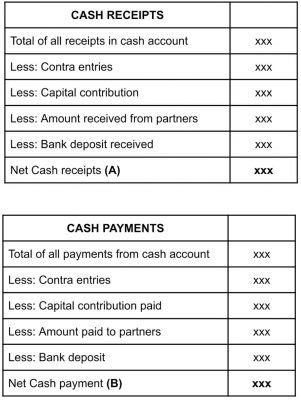How to compute 5% cash transactions limit for tax audit u/s 44AB
5 percent cash transactions limit – Tax audit u/s 44AB
This write up explains how to compute the limit of 5% of the aggregate of transactions for the purpose of tax audit u/s 44AB. As we are all aware that this is an amendment brought by the finance act 2020 so it becomes very relevant to understand what all are the adjustments required to be done for the purpose of computation of CASH balance.
What is tax audit u/s 44AB?
Section 44AB of Income Tax Act, 1961 read as follows
Every person-
- carrying on business shall, if his total sales, turnover or gross receipts, as the case may be, in business exceed or exceeds one crore rupees in any previous year
[Provided that in the case of a person whose—
(a) aggregate of all amounts received including amount received for sales, turnover or gross receipts during the previous year, in cash, does not exceed five per cent of the said amount; and
(b) aggregate of all payments made including amount incurred for expenditure, in cash, during the previous year does not exceed five per cent of the said payment,
this clause shall have effect as if for the words “one crore rupees”, the words “five crore rupees” had been substituted; or]
In other words,
Section 44AB states that where the total sales/gross receipts/turnover as the case may be exceeds the prescribed limit of one crore rupees in any previous year then such person is required to undertake audit by the authorized person.
Eligibilty criteria for Presumptive Taxation:
For an assessee who doesn’t want to undergo audit under this section and has turnover up to a prescribed limit then he has an option to pay tax at the rate of six percent or eight percent as the case may be. The benefit to assessee is that he need not maintain books of accounts but no corresponding expense shall be allowed under provisions of section 30 to 38 as the same shall be deemed to have been provided.
Now, a proviso got inserted by Finance Act, 2020 (referred above) which contains two restrictions, if met, then the limit of one crore will be substituted with five crores rupees.
To simplify further, if the two prescribed conditions are met then only those persons will be required to undertake an audit under this section whose aggregate turnover exceeds the limit of five crore rupees in a PFY.
Let’s discuss these two conditions one by one:
We have two sides in a cash account, one is receipts and the other one is the payment side. For the purpose of this proviso, we need to check the transactions contained therein.

1. Receipt side of cash account
Proviso says, if the aggregate of all amounts received including the amount received for sales, turnover or gross receipts during the previous year, in cash, does not exceed 5% of all such receipts then the limit of 5 crore rupees shall be applicable.
Now it becomes relevant to understand that what all is required to be included in CASH received?
If we refer to the receipt side of a cash account then there are many transactions like sales on a cash basis, contra entries, capital contribution and other receipts. Do we need to include all the receipts contained therein the cash account? NO, we need not to include all of those. Following are those specific transactions which are to be ‘’excluded’’ for the purpose of computing CASH limit:
a) In case of Individual/HUF, we have capital contribution received, such contribution is not to be included because of the simple reason that one cannot transact with himself. There has to be another person involved in order to constitute a cash receipt.
This confusion is created by ITR form in which the schedule therein states that “amount received will also include the capital contribution’’, this is against the spirit of the law, it cannot be counted as receipt because there have to be two different persons involved which is other than myself. One cannot receive money from himself.
Also, contra entries (if any) also need to be excluded.
b) In case of partnership firms, whether capital contribution, interest received by the partner can be counted as cash receipt or not?
The reason behind not to include these transactions within the limit is that a partnership firm is governed by partnership act, partnership deed and although for the purpose of income tax act a partnership firm is assessed as a separate assessee but in true sense partnership firm is not a legal person per se, it’s not a legal entity.
We can refer to a Supreme Court judgment CIT vs. R.N. Chidambaram Pillai as reported in 106 ITR 292 which clearly says that payment of interest and salary to partner is nothing but the apportionment of sharing of income. There is no employer and employee relation between the firm and its partners and there is no borrower or lender relation between them. That is why we do not deduct TDS u/s 194A for interest as well.
2) Payment side of cash account
Proviso says, if the aggregate of all payments made including amount incurred for expenditure, in cash, during the previous year does not exceed five percent of the said payment, then the limit of 5 crore rupees shall be applicable for the purpose of audit.
Here it becomes relevant to understand that what all is required to be included in CASH payment?
a) In case of individual/HUF, based upon the similar reasons discussed above, all the payments made are to be included except contra entries and capital contribution payment.
b) In case of partnership firms, there can be payments on account of capital withdrawal, interest on capital account, remuneration given. Following the judgment of Supreme court CIT vs. R.N. Chidambaram Pillai, as reported in 106 ITR 292, one can safely attribute and say that any transaction between the firm and its partner will not be included in cash payments.
Apart from above, there is another important aspect required to be considered which is BANK DEPOSIT, let’s understand with an example, there is an assessee who has was required to make payment to some third vendor and so he deposited cash to the bank account of such vendor located outside the state and there is no direct payment involved into the hands of vendor i.e there is no direct transaction between the assessee and its vendor and the payment has been deposited directly into his bank account.
In this particular case, we cannot record a cash entry in the books. The assessee will debit the vendor a/c and credit the corresponding Bank a/c. There is no involvement of cash. An ITAT judgment Shri Renukeshwara Rice Mill Vs. ITO reported in (2005) 93 TTJ 912, ITAT, Bangalore, where it is clearly stated that such kind of bank deposit transactions are not to be counted as cash transactions.
In nutshell,
|
CASH RECEIPTS |
|
|
Total of all receipts in cash account |
xxx |
|
Less: Contra entries |
xxx |
|
Less: Capital contribution |
xxx |
|
Less: Amount received from partners |
xxx |
|
Less: Bank deposit received |
xxx |
|
Net Cash receipts (A) |
xxx |
|
CASH PAYMENTS |
|
|
Total of all payments from cash account |
xxx |
|
Less: Contra entries |
xxx |
|
Less: Capital contribution paid |
xxx |
|
Less: Amount paid to partners |
xxx |
|
Less: Bank deposit |
xxx |
|
Net Cash payment (B) |
xxx |
These figures (A and B) are to be compared with 5% of aggregate receipts and aggregate payments respectively.
If both are within the limit of 5 percent then turnover of Rs 5 crores shall be applicable for the purpose of audit u/s 44AB.
If you already have a premium membership, Sign In.












